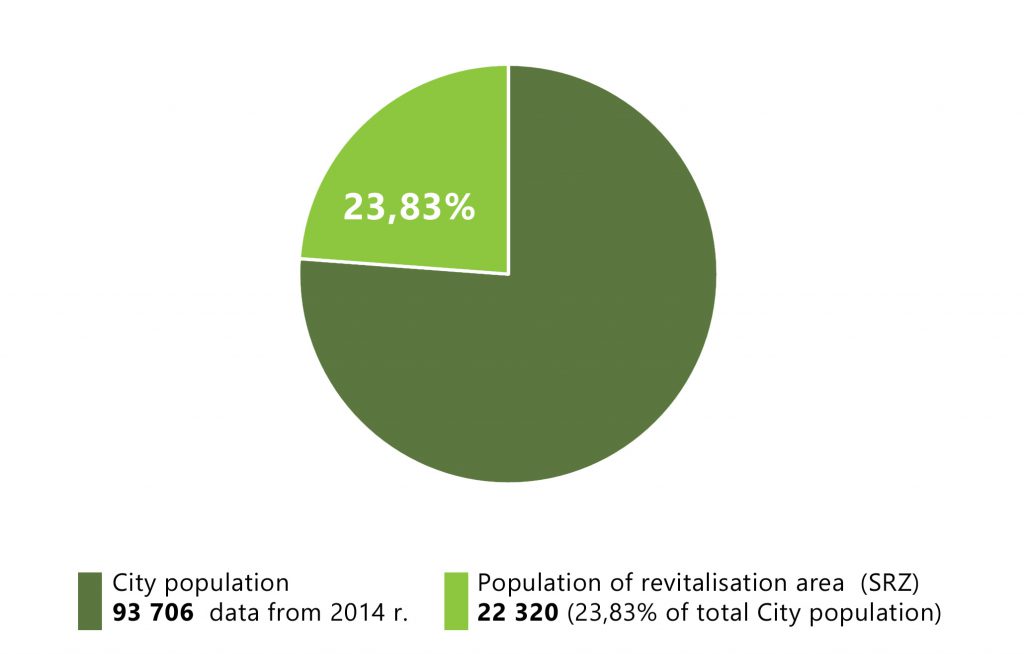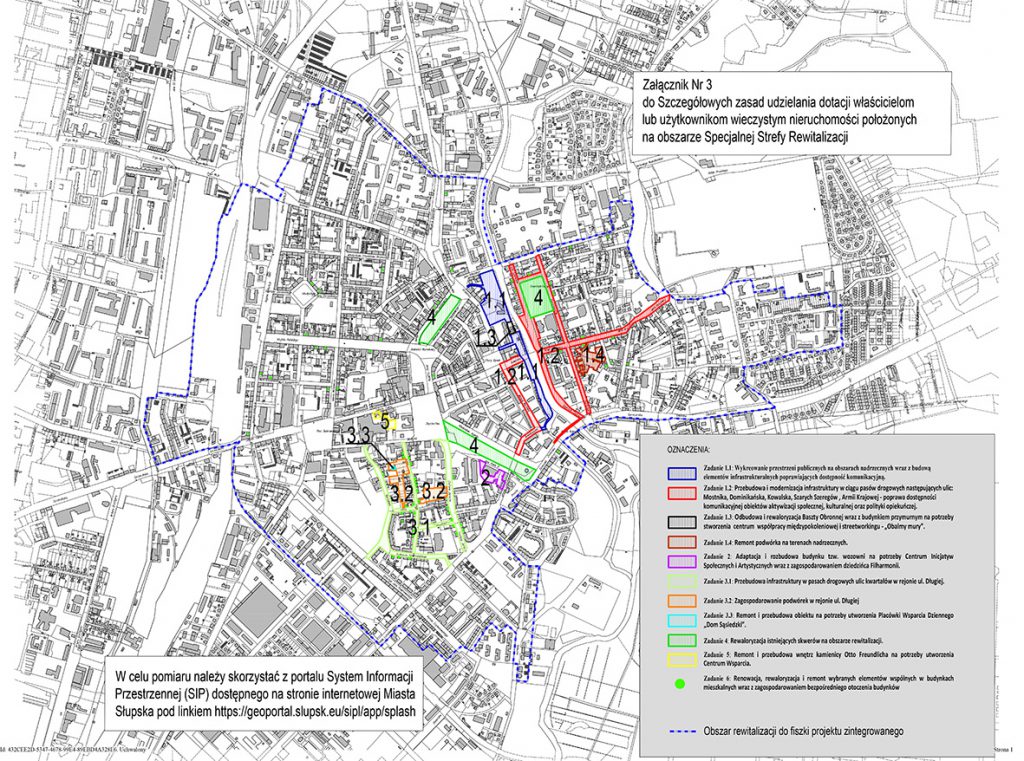

Słupsk
Period of revitalisation activities
In 2009 the first Local Revitalization Program for the City of Slupsk for 2009-2015 was launched, approved by the Slupsk City Council by Resolution No. XXXVI/514/2009 dated March 25, 2009. The purpose of the program was to improve the quality of life of residents, the state of the natural and cultural environment, as well as to restore spatial order and economic revival and rebuild social ties. Currently, revitalisation activities in the municipality are implemented on the basis of the Municipal Revitalisation Program of the Słupsk Municipality for 2017-2025+, adopted XXVI/423/20 of the Słupsk City Council on December 21, 2020. The revitalisation program is the basic document for conducting revitalisation in the municipality. The program was developed for the revitalisation area designated by Resolution No. XXIII/276/16 of the Słupsk City Council of March 30, 2016 on the designation of the degraded area and revitalization area. As a result of the diagnosis and evaluation of degraded areas in terms of a particular concentration of negative phenomena, the revitalisation area of 272 hectares, inhabited by 22,320 people, was created.
Characteristics of the revitalisation area problems
- Social sphere
In order to analyse the state of social deficits in the designated revitalisation area, attention should be focused on the strong interconnection of a number of factors that interact with each other. The challenge for the city is to provide support to the growing number of older people. The values of the indicator both for the revitalisation area and for the city exceed the reference values for Poland and Pomorskie Voivodeship, indicating the progressive ageing of the population. Another very important social problem is the phenomenon of unemployment, especially long-term unemployment. In Slupsk, almost every second unemployed person lives in the revitalization area. In comparison, the unemployment rate in the revitalisation area is more than half higher than in the city, more than 2.5 times higher than in the Pomeranian Voivodeship, and more than 2 times higher than in Poland. The phenomenon of unemployment is often related to another problem – poverty. According to statistics, the number of people receiving social assistance benefits in the revitalisation area was more than 2 times higher than for the whole city and 1.5 times higher in relation to the reference values for Poland and the Pomeranian Voivodeship. Another negative phenomenon affecting the revitalisation area is the incidence of crime.
- Spatial and functional sphere
The revitalization area is characterized by a wide variety of functions characteristic of downtown and old town districts. It forms the broad centre of the city, also as a geografic and urban structure. Almost the entire revitalisation area includes the historic urban assumptions of the city, Podgrodzie and Śródmieście, which have mostly preserved their historic spatial structure, with compact quarter buildings with a dominant residential function that occupies almost half of the built-up area. The basic form of development, in the case of the commercial streets, are 4-levels townhouses with commercial units on the first floor. In the revitalisation area, there is a concentration of public buildings. In spite of the residential units, almost ¼ of the space is occupied for services: retail, educational, cultural, administrative, health, and religious.
Socio-economic transformations in recent decades have caused a number of unfavourable processes in the City, the effects of which are most visible in the revitalisation area. Changing lifestyles and residents’ expectations of public spaces, as well as increasing car transport, have contributed to the progressive process of suburbanisation. The phenomenon of suburbanisation and the ageing of the population has resulted in the depopulation of the city centre on the one hand, and the occupation of central areas by less affluent groups of residents, often with multiple social problems.
- Technical sphere
Regardless of its high urban and architectural value, the revitalisation area has become technically degraded as a result of many years of negative development and planning and housing policies. It should be noted, however, that the equipment of residential facilities with basic utilities is very high. Almost all residential units are equipped with water and sewerage, and almost all have been supplied with gas connections. Toilets located on the floors (corridors) have been almost eliminated. The biggest problem is the supply of heat sources and there is a relatively small part of residential units are supplied with district heating. At the same time, it should be emphasised that almost all multi-family buildings, especially those built after 1960, and all public buildings are connected to the municipal district heating network.
- Environmental sphere
Almost all residential structures built before 1945 are still heated from individual heat sources, with coal-fired stoves. Poor fuel quality combined with unfavourable topography results in poor air quality throughout most of the city, including the regeneration area. Despite the fact that Słupsk in recent years has been the only medium-sized city to reach air quality standards (average annual concentrations within the norm), at measuring stations located in the city centre, PM10 dust and benzoalpha-pyrene concentrations are exceeded several dozen times a year. Although almost the entire revitalisation area is developed with a district heating network, the possibility of changing the heat source to a networked one is of low interest due to the high cost of conversion or new construction inside the property.
- Economic sphere
Due to the inner-city character of the development and the existing land use established by the local development plans, the revitalisation area is not a place of activity of large manufacturing companies, but an area dominated by micro and small enterprises and family businesses operating in the service and commercial sector. The revitalisation area continues to have a high rate of economic activity, but losing it year after year, particularly in the retail and services area. In recent years, there has been a noticeable decreasing rate of new business start-ups, which may be related to the saturation of the local market with businesses and the need to make competition with representatives of large retail and service chains operating within the city, including in the city centre. The declining number of start-ups is also due to the rising cost of doing business and the decreasing availability of skilled workers in the local labour market. Most of the entrepreneurs operating in the revitalisation area indicate that they have problems recruiting employees, resulting in the closure or suspension of their businesses. Among the businesses carried out, trade and service activities predominate. The greatest deficit of businesses run in the revitalisation area is in innovative technology industries. It should be noted that the revitalisation area has excellent conditions for the development of startups.
Description of the building’s character in the revitalisation area
There are two housing structures to be distinguished in the revitalisation area. The first complex is located within the city borders and accounts for approximately 10% of the revitalisation area. This complex is built up with multi-family buildings (blocks of flats), related to the reconstruction of the Old Town destroyed in March 1945 – Old Town. The second group, located in the revitalisation area consists of tenement houses, most of which form compact frontages. The dominance of residential functions, as well as the short distance to the city center, has determined the shape of the street buildings. Large rented townhouses with rich decorations were usually built along the main streets.
Due to the lack of war damage and the almost complete development of the building parcels, there was no possibility of constructing new buildings in this area. As a result, nearly 80% of the entire housing stock is of pre-war origin, and the average age of buildings in the revitalisation area approaches 100 years. From the total number of 268 buildings, completely owned by the city, built after 1990, there are only 12. Lack of funding for renovation is the reason of the poor technical condition of most residential buildings. Municipal facilities located in the revitalisation area are also in bad technical condition.
Main revitalisation activities
The revitalization program assumes the implementation of so-called “hard” and “soft” projects such as:
- complex modernization and renovation of residential buildings,
- renovation of historic and sacred buildings,
- demolition of commercial units that are in poor technical condition,
- improvement of energy efficiency of public facilities,
- improvement of the quality of urban spaces: development of intra-quarter interiors (courtyards), revalorization of existing squares,
- reconstruction of the Old Market,
- modernization of social infrastructure,
- reconstruction (modernization) of technical infrastructure,
- adaptation of unused buildings, including historic buildings, for social and cultural purposes.
The program also envisages the implementation of a number of so-called ‘soft’ projects aimed at improving the quality of education, the integration of representatives of different social and age groups, and the professional activation of people at risk of social exclusion and the activation of elderly people. The total cost of the basic and supplementary projects is PLN 467,775,522.
Establishment & tools for Special Revitalisation Zone (SRZ)
- Date of establishing the SSR: 2021 r.
- Area of the SSR: Revitalization area settled by Resolution No. XXIII/276/16 of the Słupsk City Council of March 30, 2016.
- Tools indicated in the SSR: grants to owners and perpetual users of all types of real estate, regardless of the functions they perform; the powers and prohibitions of the City of Slupsk, i.e. the right of first refusal and the prohibition on issuing zoning decisions in the revitalization area, expired on June 7, 2018.
- Level of co-financing in the SSR: Up to 50% of the net expenditures incurred subsidy amount, the maximum subsidy threshold per property is PLN 100,000.
- Procedure for the call of grants in the SRZ: Within 14 days after the budget of the City of Slupsk for a given fiscal year was established.
- Deadline for submitting grant applications to SRZ: Within a period – not less than 30 days from the announcement of the call.
- Composition of the evaluation committee: Employees of the substantively competent departments of the City Hall.
- Number of announced calls for applications: 1
- Number of subsidies awarded in individual calls: 2022 – 10
- Link to the resolution on the SSR: XXXVII/573/21 – Uchwały Rady Miejskiej – Biuletyn Informacji Publicznej Miasta Słupska (um.slupsk.pl)
- Link to the publication promoting the SSR prepared by the city: Specjalna Strefa Rewitalizacji (www.slupsk.pl)
